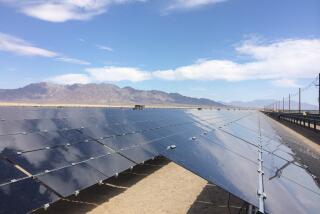As Fads Change, Solar Energy Still âInâ
Most things seem to go in circles--perhaps âcyclesâ-- although it often seems that âfashionsâ or even âfadsâ better describe the process.
There is a story about a used-clothing merchant who would buy up stocks of womenâs clothes as they slipped out of fashion, on the theory that if he held them long enough, theyâd come back in style and heâd be able to sell them.
He bought lots of the long cotton stockings with horizontal black-and-white bands, like a raccoonâs tail, that were stylish with bathing suits in the immediate pre- (or post-) World War I era. So far, theyâre the only item he hasnât been able to resell!
The cyclic nature of many things isnât really in doubt. At the moment, public concern with energy conservation seems to be in a down cycle. Thatâs happened before, but this time thereâs a difference.
Talking just about Southern California, by the 1880s the residents found fuel hard to come by; wood was scarce and expensive, coal was imported and expensive and the new âcoal gasâ was inefficient and expensive. They often heated dish washing and bathing water in pans or cans set out in the sun, which was inconvenient but cheap.
Solar systems that supplied hot water inside the house were introduced about 1890, and the technology improved until very efficient solar equipment, inexpensive relative to the cost of other fuels, was widespread from about 1920 on. Estimates of the number of Southland homes with solar water-heating systems vary from 20,000 to more than 30,000 about 1930.
Then, in the early 1930s, natural gas was discovered in the Southland, abundant and cheap. The solar industry withered on the vine.
Some people continued working with solar, but it wasnât until the gasoline crunch of 1973-74 that widespread interest revived. Solar heating systems became more common, knowledge spread along with concern, Presidents and governors led the campaign for national energy sufficiency through energy conservation. Solar and other renewable-source energies were officially encouraged through tax credits by the federal government and many states.
Those tax-credit inducements are currently under fire and probably will be phased out, rather than being killed outright. But a flourishing solar energy industry has been created and, given any treatment better than being hit on the head with an ax, should survive.
Many people are more optimistic than that; they feel the pendulum is due to swing back since awareness is strong both among the consuming public and the designing and building professionals.
But there is a difference, a hopeful one. The upsurge in interest in solar energy was mainly concerned with what are called âactiveâ systems, solar energy collectors and heat storage and distribution devices, mainly used to furnish hot water to homes and to warm swimming pools.
The difference is this: Although general interest has retreated from its earlier high pitch, it remains strong. Public attention has broadened to include what is known as âpassiveâ solar, the philosophy and practice of designing a house so that it is, in itself, a solar system, both collector and heater/cooler.
This expertise covers such commonly known factors as weatherstripping and continues on to rather sophisticated concepts, such as using the natural tendency of hot air to rise to make it lift itself to the top of a house and out through vents, sucking cool air in at the bottom (called the âstack effectâ because basically itâs the way a chimney works).
Those matters and many more are covered in an excellent, comprehensive and well-written book, âAffordable Passive Solar Homes--Low-Cost Compact Designsâ by Richard I. Crowther, a fellow of the American Institute of Architects and author of other works on the general subject.
The authorâs purpose is to detail ways in which compact to moderately sized passive solar houses can be built at costs comparable to conventional homes--the âAffordableâ in the title. He contends this can be done by avoiding unnecessary costs through such means as sizing the home to meet the residentsâ specific needs, specifying less expensive materials and putting a great deal of informed thought into room layouts.
Part 1 is headed âDesign Considerationsâ and I didnât notice any aspect of that subject that was not covered.
Part 2 offers 49 home designs with conceptual perspective drawings, sectional views and floor plans, including single-family houses, condominiums, joined multiple housing, vacation homes, studios and survival shelters.
The book throughout is concerned with principles and methods of putting them into practice, written in clear, pleasurable English. Nine appendixes contain the more technical material. The book can be understood and learned from by the lay person and also serves up much meat to the professional designer, builder or other home-producer.
âAffordable Passive Solar Homesâ is published in well-made paperback format, 8 by 10 inches, with 188 pages and 184 illustrations. It may be ordered by mail for $24 from SciTech Publishing Co., P. O. Box 587, 930 S. Monaco Parkway, Denver, Colo. 80224.
More to Read
Inside the business of entertainment
The Wide Shot brings you news, analysis and insights on everything from streaming wars to production â and what it all means for the future.
You may occasionally receive promotional content from the Los Angeles Times.










